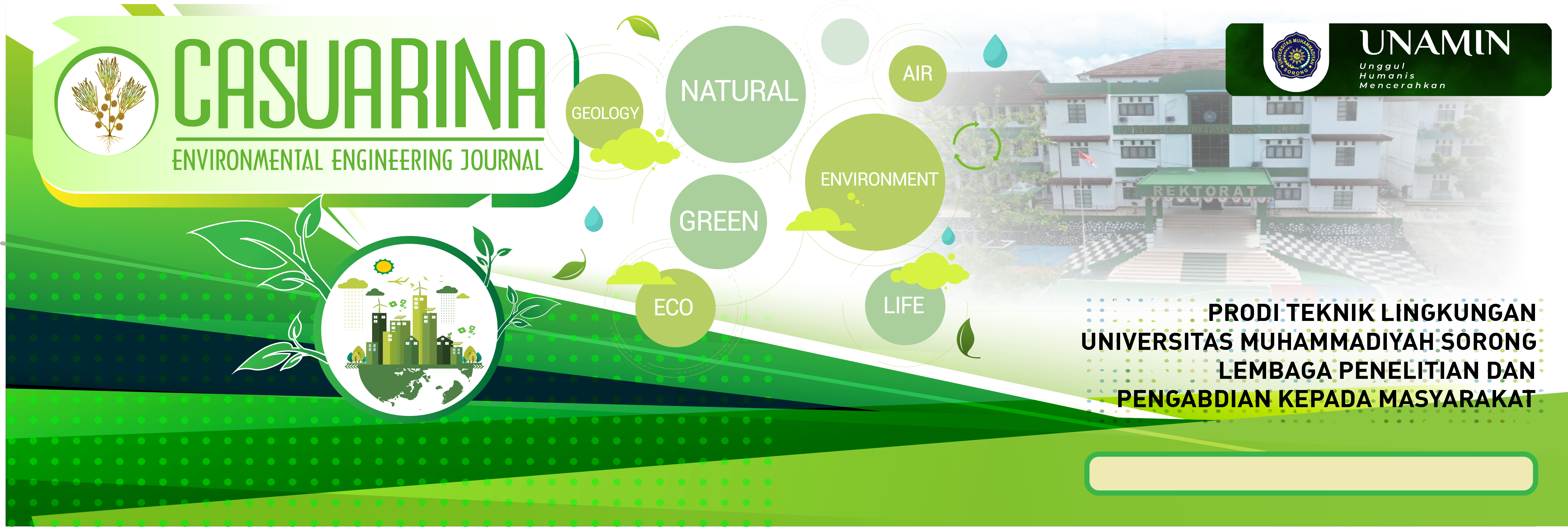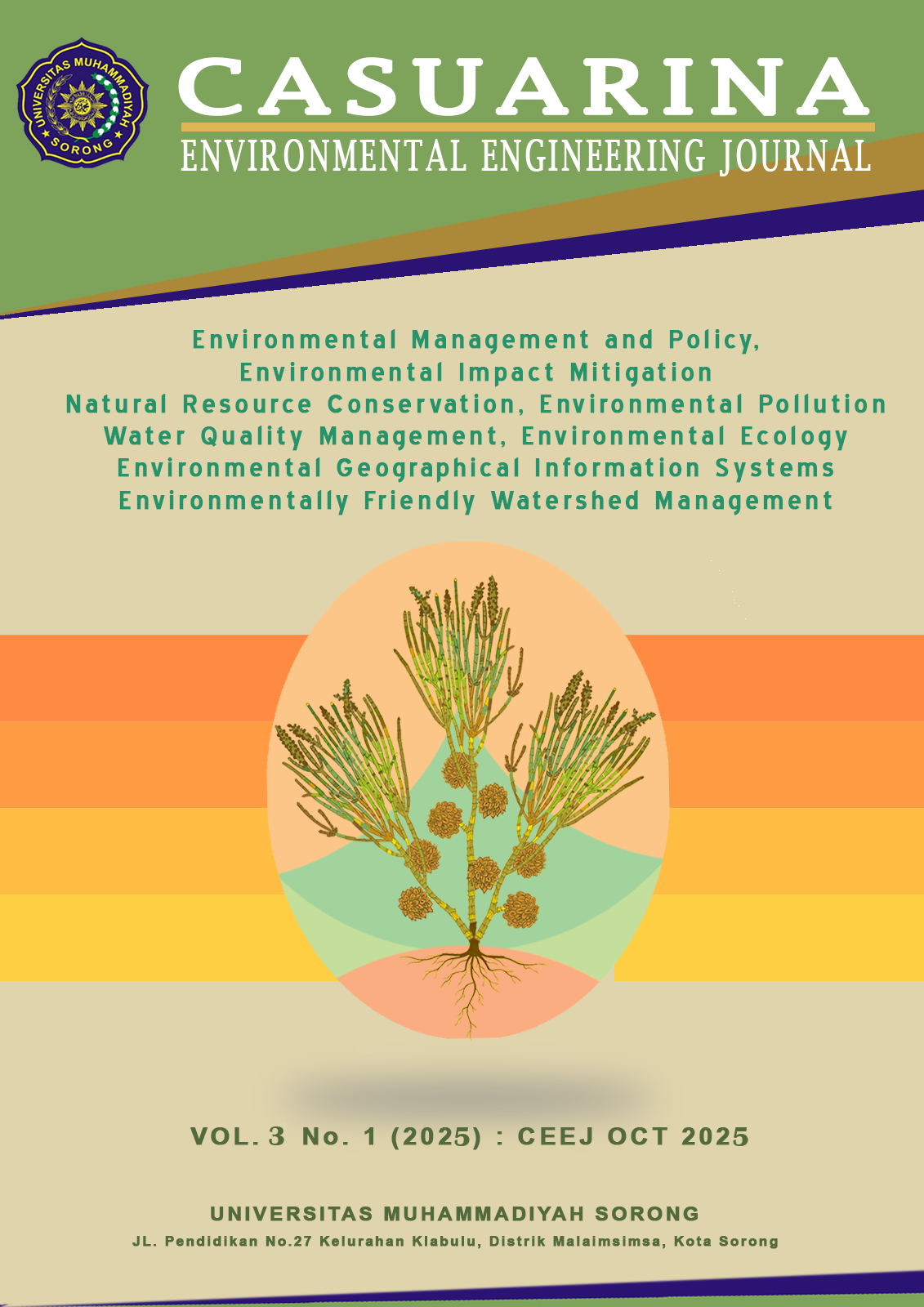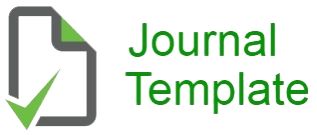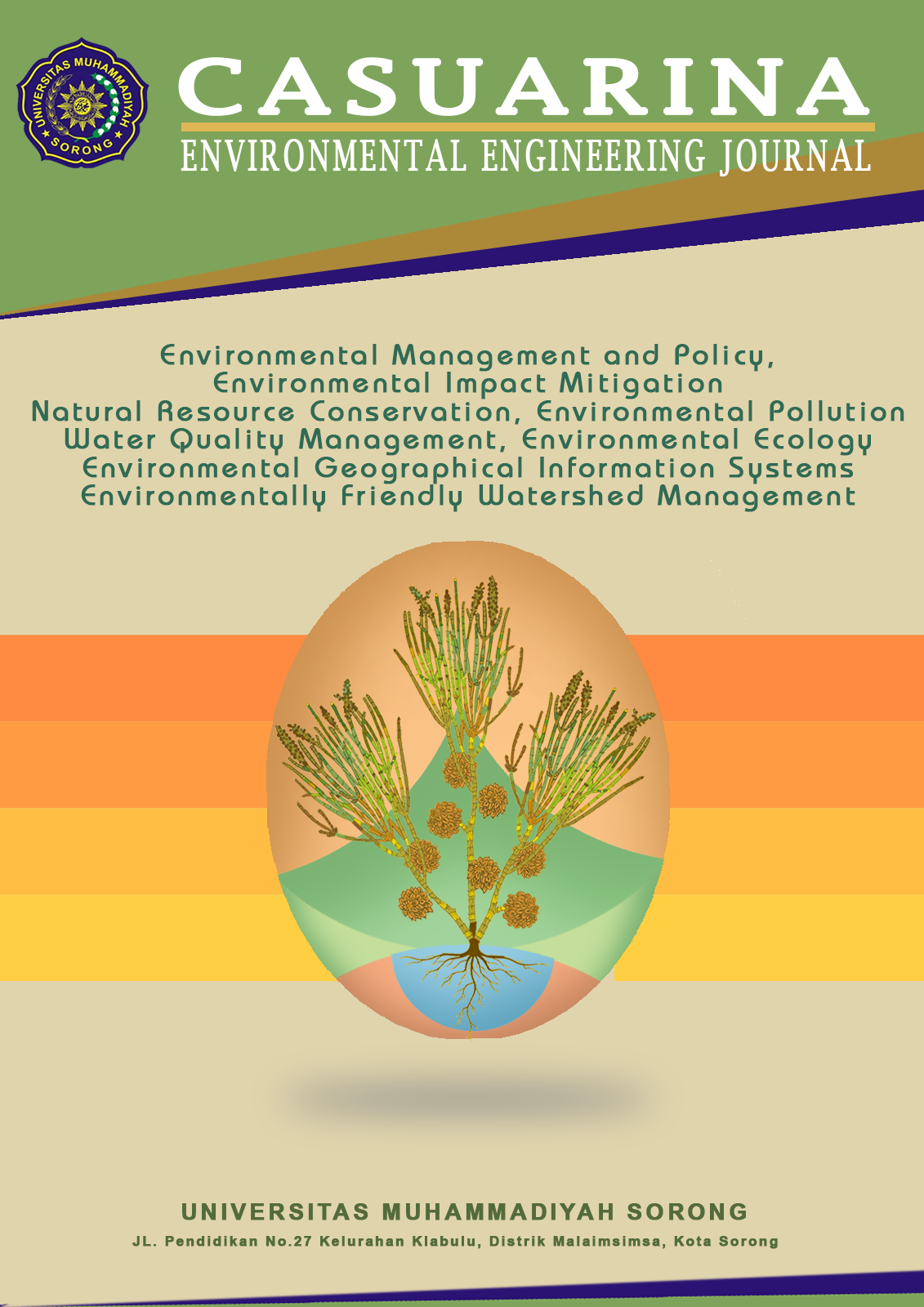Studi Dasar Kesehatan Lingkungan di Kecamatan Hu’u, Sumbawa Barat, NTB, Indonesia
Bahasa Indonesia
DOI:
https://doi.org/10.33506/ceej.v3i1.4937Kata Kunci:
Kualitas Udara, Kualitas Lingkungan, Kualitas Air Tanah, Kualitas TanahAbstrak
Kualitas lingkungan yang baik sangat penting untuk mendukung kehidupan dan perkembangan masyarakat secara optimal. Kecamatan Hu’u, Kabupaten Dompu, memiliki potensi sumber daya alam yang melimpah, namun aktivitas manusia, terutama pertanian, dapat memengaruhi kondisi lingkungan setempat. Penelitian ini bertujuan untuk mengevaluasi kondisi kesehatan lingkungan di Kecamatan Hu’u dengan fokus pada parameter kualitas air tanah, tanah, dan udara berdasarkan standar Peraturan Menteri Kesehatan Republik Indonesia Nomor 2 Tahun 2023. Sampling kualitas lingkungan dilakukan pada periode bulan basah (Februari–Maret 2023) di sembilan lokasi untuk air tanah, sepuluh lokasi untuk sampel tanah, dan lima lokasi untuk pemantauan udara di sekitar desa-desa di Kecamatan Hu’u. Analisis fisika, kimia, dan mikrobiologi dilakukan untuk menilai kualitas air dan tanah. Hasil penelitian menunjukkan beberapa parameter air tanah, seperti warna, kekeruhan, dan total padatan terlarut (TDS), melebihi ambang batas yang ditetapkan, kemungkinan akibat zat organik alami, pelarutan mineral, dan aktivitas pertanian. Total koliform terdeteksi di beberapa titik yang mengindikasikan potensi kontaminasi limbah domestik, meskipun Escherichia coli tidak ditemukan. Konsentrasi logam berat Barium (Ba), Tembaga (Cu), dan Seng (Zn) pada beberapa lokasi tanah melebihi baku mutu, diduga berhubungan dengan aktivitas pertanian dan karakter geologi aktif. Selain itu, kualitas udara untuk parameter kimia udara ambien masih tergolong baik, namun konsentrasi karbon monoksida (CO) perlu menjadi prioritas pemantauan karena berpotensi meningkat akibat aktivitas pembakaran limbah pertanian. Temuan ini menjadi dasar penting dalam penyusunan kebijakan pengelolaan lingkungan yang adaptif di wilayah Hu’u guna menjaga keberlanjutan ekosistem dan kualitas hidup masyarakat.
Referensi
1. Suryani AS. Pengaruh kualitas lingkungan terhadap pemenuhan kebutuhan dasar di Provinsi Banten. Aspirasi: Jurnal Masalah-Masalah Sosial. 2018;9.
2. Ekiawan MA. Pengelolaan lingkungan hidup dalam norma hukum Indonesia. Jurnal Rechten: Riset Hukum dan Hak Asasi Manusia. 2023;5(2):34–42.
3. Mahour K. Human Population Concept in Present Scenario. Journal of Advanced Laboratory Research in Biology. 2014;5(4):198–204. 4. Bagova Z, Zhantasov K, Bektureeva G, Naukenova A, Ilari JR. Environmental impact and human life at the construction and operation of new industrial objects. Industrial Technology and Engineering. 2019;1(30):40–8.
5. Alam A, Mahmood A, Chaudhry MN, Ahmad SR, Safa NU, Alghamdi HA, et al. Baseline study in environmental risk assessment: site-specific model development and application. Archives of Environmental Protection. 2022;48(3):80–8.
6. Paryono, Nurliah, Rahman I, Himawan MR. Sebaran Bakteri Coliform Sebagai Indikator Pencemaran Biologis Di Beberapa Sumber AirKecamatan Hu’u, Kabupaten Dompu. JURNAL
SAINS TEKNOLOGI & LINGKUNGAN. 2023 Jun 30;9(2):310–7.
7. Irfan M., Fathony MY, Asy’ari H. Implikasi penerapan corporate social responsibility (CSR) sebagai bentuk tanggung jawab perusahaan pertambangan di Kecamatan Hu’u Kabupaten Dompu. Jurnal Risalah Kenotariatan. 2021;2.
8. Nurhidayah, Widayanti BH. Analisis pengaruh produksi komoditas jagung terhadap pengembangan wilayah di Kecamatan Manggelewa Kabupaten Dompu. Jurnal Planoearth. 2017;2(1):24–30.
9. Kementerian Kesehatan Republik Indonesia. Peraturan Menteri Kesehatan Republik Indonesia
Nomor 2 Tahun 2023 tentang Peraturan Pelaksanaan Peraturan Pemerintah Nomor 66 Tahun 2014 tentang Kesehatan Lingkungan. Berita Negara Republik Indonesia Tahun 2023 Nomor 55 2023.
10. Umutesi O, Sajidan, Masykuri M. Groundwater quality and public health of the community around Mojosongo landfill, Surakarta city. In: AIP Conference Proceedings. American Institute of Physics Inc.; 2018.
11. Purwaka PB, Wijanarko SA. Uji Banding Kinerja Alat High Volume Air Sampler untuk Pengukuran Total Suspended Particulate (TSP) di Udara Ambien. ECOLAB. 2022 Nov 16;16(2):87–98.
12. Nelson D, Drinking O, Services W. Natural Variations in the Composition of Groundwater. Groundwater Foundation Annual Meeting, Springfield, Oregon, Amerika Serikat: Oregon Department of Human Services. 2002;
13. Kabir A, Ahmed A, Rahman M, Md Taimur I, Ahmad S, Khan MM, et al. Root cause of groundwater colouration in coastal districts of Bangladesh: findings from a preliminary study. Environmental Pollutants and Bioavailability. 2021;33(1):425–36.
14. Ningrum SO. Analisis Kualitas Badan Air dan Kualitas Air Sumur di Sekitar Pabrik Gula Rejo Agung Baru Kota Madiun. Jurnal Kesehatan Lingkungan. 2018;10(1):1–12.
15. Aswir. Analisis pencemaran air Sungai Tapung Kiri oleh limbah industri kelapa sawit PT. Peputra Masterindo di Kabupaten Kampar. Universitas Diponegoro; 2006. 16. Radityo D, Pratomo SU. Study on the influence of salinity, TDS, GWL and land use in the
coastal region of Kebumen Regency with a statistical approach. IOP Conf Ser Earth Environ Sci. 2024;1339(1).
17. BPTP NTB. Laporan Tahunan Balai Pengkajian Teknologi Pertanian Nusa Tenggara Barat 2018 [Internet]. 2019 [cited 2025 Sep 17]. Available from: https://ntb-bsip-ppid.pertanian.go.id
18. Patmawati, Sukmawati. Menurunkan Bakteri Total Coliform Wai Sauq Bantaran Sungai Mandar Dengan Chlorine Diffuser. Higiene. 2019;5(2).
19. Bosch AC, O’Neill B, Sigge GO, Kerwath SE, Hoffman LC. Heavy metals in marine fish meat and consumer health: A review. J Sci Food Agric. 2016;96(1):32–48.
20. Intan FS. Struktur geologi kawasan Hu’u dalam kaitannya dengan pemilihan lokasi situs megalitik. Jurnal Walennae. 2016;14(1):11–22.
21. Kurniawan A. Pengukuran Parameter Kualitas Udara (CO, NO2, SO2, O3 DAN PM10) di Bukit Kotatabang Berbasis ISPU. Jurnal Teknosains. 2017;7(1).
22. Budianto A, Hadi KA, Illahi RR, Anggriani NK, Wardi PH, Pranahita DD. Pemantauan Kualitas Udara Berdasarkan Tinjauan Konsentrasi dan Faktor Emisi Partikulat di Pulau Lombok. Lambda Jurnal Ilmiah Pendidikan MIPA dan Aplikasinya. 2025 Apr 30;5(1):147–53.
23. Hafidawati. Karakteristik Emisi Black Carbon (BC) Dari Pembakaran Terbuka Jerami Padi dan Dampak Terhadap Kualitas Udara Ambien. EcoNews: Advancing the World of Information and Environment. 2018;1:72–80.
Unduhan
Diterbitkan
Cara Mengutip
Terbitan
Bagian
Lisensi
Hak Cipta (c) 2025 Casuarina: Jurnal Teknik Lingkungan

Artikel ini berlisensiCreative Commons Attribution-NonCommercial-ShareAlike 4.0 International License.
Please find the rights and licenses in Casuarina: Environmental Engineering Journal. By submitting the article/manuscript of the article, the author(s) agree with this policy. No specific document sign-off is required.
1. License
The non-commercial use of the article will be governed by the Creative Commons Attribution license as currently displayed on Creative Commons Attribution-NonCommercial-ShareAlike 4.0 International License.
2. Author(s)' Warranties
The author warrants that the article is original, written by the stated author(s), has not been published before, contains no unlawful statements, does not infringe the rights of others, is subject to copyright that is vested exclusively in the author, and free of any third party rights, and that any necessary written permissions to quote from other sources have been obtained by the author(s).
3. User/Public Rights
Casuarina: Environmental Engineering Journal's spirit is to disseminate articles published are as free as possible. Under the Creative Commons license, Casuarina: Environmental Engineering Journal permits users to copy, distribute, display, and perform the work for non-commercial purposes only. Users will also need to attribute authors and Casuarina: Environmental Engineering Journal on distributing works in the journal and other media of publications. Unless otherwise stated, the authors are public entities as soon as their articles got published.
4. Rights of Authors
Authors retain all their rights to the published works, such as (but not limited to) the following rights;
- Copyright and other proprietary rights relating to the article, such as patent rights,
- The right to use the substance of the article in own future works, including lectures and books,
- The right to reproduce the article for own purposes,
- The right to self-archive the article (please read our deposit policy),
- The right to enter into separate, additional contractual arrangements for the non-exclusive distribution of the article's published version (e.g., post it to an institutional repository or publish it in a book), with an acknowledgment of its initial publication in this journal (Casuarina: Environmental Engineering Journal).
5. Co-Authorship
If the article was jointly prepared by more than one author, any authors submitting the manuscript warrants that he/she has been authorized by all co-authors to be agreed on this copyright and license notice (agreement) on their behalf, and agrees to inform his/her co-authors of the terms of this policy. Sentralisasi will not be held liable for anything that may arise due to the author(s) internal dispute. Sentralisasi will only communicate with the corresponding author.
6. Royalties
Being an open accessed journal and disseminating articles for free under the Creative Commons license term mentioned, author(s) aware that Casuarina: Environmental Engineering Journal entitles the author(s) to no royalties or other fees.
7. Miscellaneous
Casuarina: Environmental Engineering Journal will publish the article (or have it published) in the journal if the article editorial process is successfully completed. Casuarina: Environmental Engineering Journal's editors may modify the article to a style of punctuation, spelling, capitalization, referencing, and usage that deems appropriate. The author acknowledges that the article may be published so that it will be publicly accessible and such access will be free of charge for the readers as mentioned in point 3.








